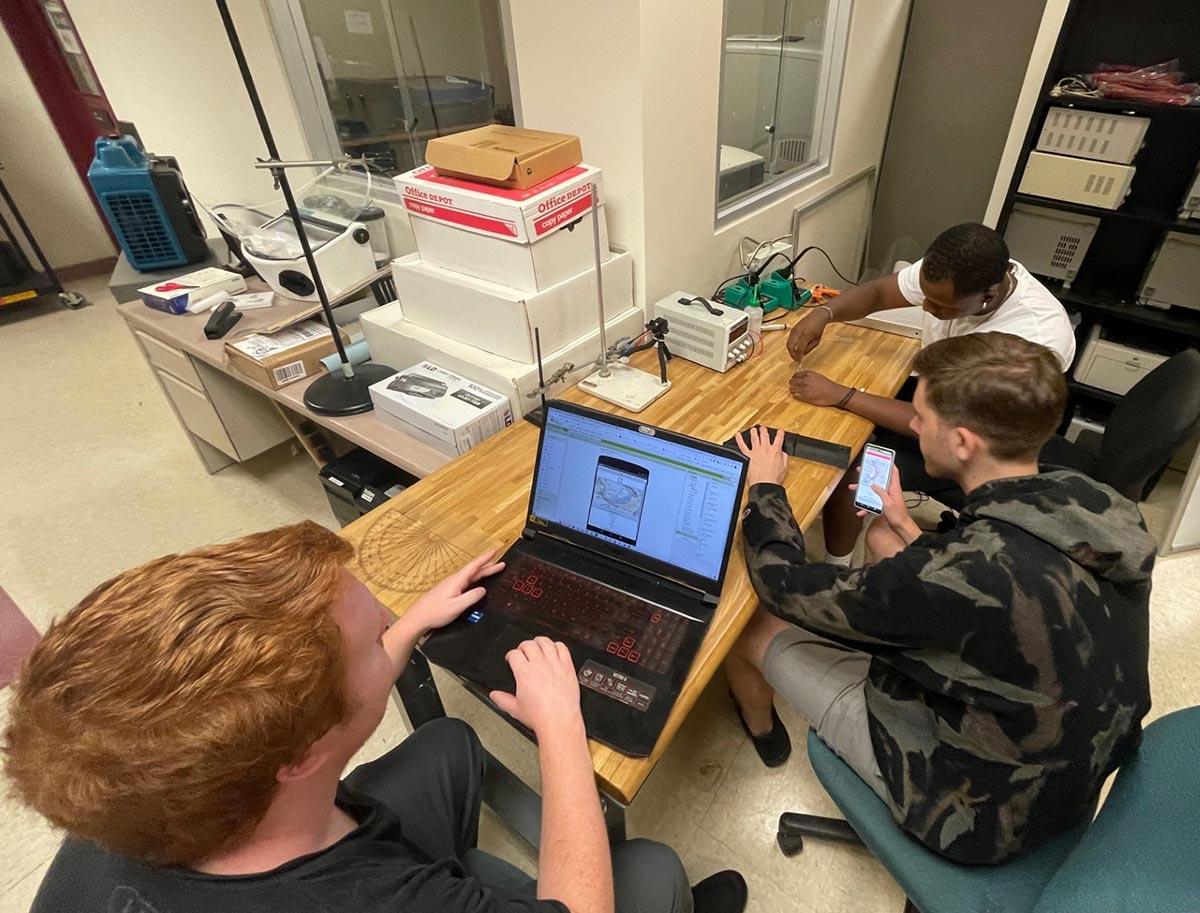 Left to right: Barrett, Rodos and Phillips work on the device.
Left to right: Barrett, Rodos and Phillips work on the device.
Water quality is a global concern affecting millions of people worldwide.
Recognizing the significance of this issue, a senior design team has
developed a groundbreaking solution — a "smart fluorometer." This innovative
water quality sensor, accompanied by a user-friendly app, aims to empower
individuals to test, track, and share local water quality results using
their smartphones.
The team, comprised of engineering technology majors Darius Phillips, John Barrett and Eric Rodos, combined their
diverse expertise to create a simple, compact, and cost-effective instrument
that harnesses smartphone technology. The smart fluorometer utilizes a
specific reagent to induce fluorescence in a water sample when contaminants
are present. The smartphone's camera captures the fluorescence, and the
team's software interprets the results, providing accurate and real-time
information on water quality. The app marks the results with timestamps and
location data, allowing users to identify trends and patterns over time.
Water quality is a pressing issue that demands localized solutions. The
Smart Fluorometer generates precise and reliable data, enabling communities
to plan targeted cleanup efforts and monitor their effectiveness. By
empowering individuals to identify and mark contaminated water supplies, the
team hopes to make a tangible impact in improving water quality around the
world.
"We realized that issues with water are widespread, affecting both developed
and developing regions,” said Rodos. “Recent events in Flint, Michigan, and
East Palestine, Ohio highlighted the urgency of addressing this problem. We
wanted to contribute to the solution by developing a practical and
accessible tool that could help people access clean water."
The team's collaborative approach played a pivotal role in overcoming
challenges during the development process. Barrett, responsible for the
software aspects of the project, emphasized the importance of their diverse
skill sets. "We formed this team because we believed our individual
strengths would complement each other,” he said. “My software abilities,
Darius's experience with optics, and Eric’s interest in environmental issues
provided a strong foundation for tackling the task at hand."
Phillips shared insights into the team's biggest challenge, stating,
"Integrating all the components into a cohesive system proved to be our most
significant obstacle. While each subsystem performed well independently,
making them work together seamlessly required considerable effort. For
instance, the optical subsystem's design and testing were relatively
straightforward, and the programming software had an extension to read data
from the user's phone light sensor. However, it took us two weeks to achieve
consistent and accurate readings. Fortunately, my college experiences and
education equipped me with the necessary knowledge and skills in chemistry,
circuitry, optical physics, modeling and simulation, and programming. Design
and testing, problem-solving, and analytical thinking were vital skills that
helped us overcome these challenges."
The team's hard work and perseverance have paid off, culminating in the
creation of the smart fluorometer and its accompanying app. They envision a
future where their concept is applied to enable individuals to identify and
flag contaminated water sources, creating a safer and healthier environment
for all.